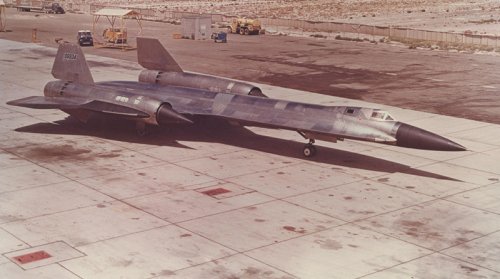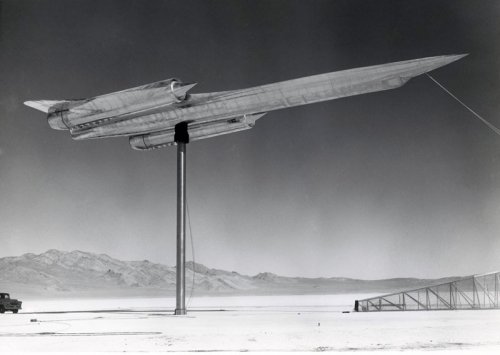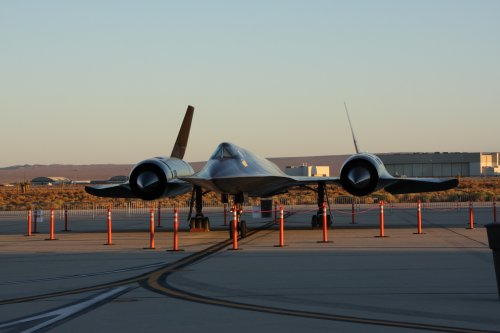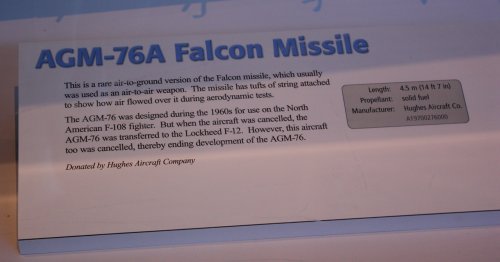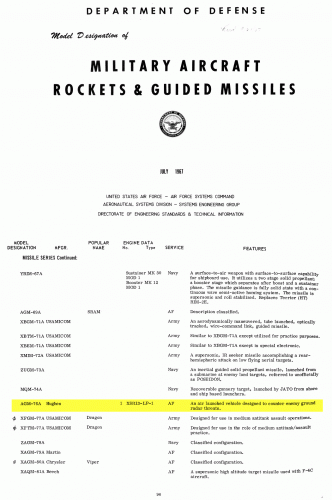You are using an out of date browser. It may not display this or other websites correctly.
You should upgrade or use an alternative browser.
You should upgrade or use an alternative browser.
Bare metal YF-12A at Groom, mid-1963
- Thread starter vulture
- Start date
vulture
ACCESS: Confidential
- Joined
- 25 September 2009
- Messages
- 96
- Reaction score
- 12
Note that the above missiles, two images are of the Hughes XAGM-76 air to surface missiles - an air to ground development of the AIM-47 Super Falcon. It would appear that the YF-12 was designed with a ground strike capability, not just an interceptor.
Matej
Multiuniversal creator
Interesting. Please mention the source if possible.
- Joined
- 25 June 2009
- Messages
- 13,776
- Reaction score
- 3,045
I find it hard to reconcile the shape of the F-12 with a strike/attack type of mission... I have that notion that strike aircraft are preferably squat so they make short turn more easily and resist better to stress and metal fatigue... An elongated interceptor seems awkward for this type of role... but I'm no engineer and so I'm probably wrong...
vulture
ACCESS: Confidential
- Joined
- 25 September 2009
- Messages
- 96
- Reaction score
- 12
The source of the above is the CIA histories on the Blackbird family. As to Stargazer's concern, the AGM-76 had the same speed of its AIM cousin - Mach 5 and was a SRAM type weapon. Its mission would have been strategic - not tactical, there was not to be any "tight maneuvering to put the airframe in an over stress condition. Very difficult to defend against.
Vulture
Vulture
- Joined
- 6 August 2007
- Messages
- 3,011
- Reaction score
- 2,306
vulture said:The source of the above is the CIA histories on the Blackbird family. As to Stargazer's concern, the AGM-76 had the same speed of its AIM cousin - Mach 5 and was a SRAM type weapon. Its mission would have been strategic - not tactical, there was not to be any "tight maneuvering to put the airframe in an over stress condition. Very difficult to defend against.
Vulture
AGM-76 was a conventional ARM, if memory serves.
blackkite
Don't laugh, don't cry, don't even curse, but.....
- Joined
- 31 May 2007
- Messages
- 8,297
- Reaction score
- 5,904
Thank you for sharing very rare pictures.
Radar dome, shock cone and outer wing leading edges are already painted?
I wonder this fighter already flown or not when taking this pictures.
Radar dome, shock cone and outer wing leading edges are already painted?
I wonder this fighter already flown or not when taking this pictures.
- Joined
- 3 October 2007
- Messages
- 1,962
- Reaction score
- 1,029
quellish said:vulture said:The source of the above is the CIA histories on the Blackbird family. As to Stargazer's concern, the AGM-76 had the same speed of its AIM cousin - Mach 5 and was a SRAM type weapon. Its mission would have been strategic - not tactical, there was not to be any "tight maneuvering to put the airframe in an over stress condition. Very difficult to defend against.
Vulture
AGM-76 was a conventional ARM, if memory serves.
It's noteworthy that virtually all information on the missile seems to be paraphrases of information from two individuals, one of which is the well respected Andreas Parsh. As far as warheads go, some of the citings say it had a 250 KT thermonuclear warhead and some say 250 lb high explosive. Interesting that both use the number 250. I
OM
ACCESS: Top Secret
Kokoro said:Looks amazing.
...Yeah, but you have to admit it looks a *LOT* better in that flat black we've come to know and love. 40 years later, this is still a plane that should be flying every damn day, pushing ever damn envelope, and anyone who says otherwise should be strapped to a D-21 and released over hostile territory. Starting with the Air Farce generals who grounded the Habu in the first place.
F-14D said:It's noteworthy that virtually all information on the missile seems to be paraphrases of information from two individuals, one of which is the well respected Andreas Parsh.
...A man that this Habu lover is extremely envious of, natch.
- Joined
- 6 August 2007
- Messages
- 3,011
- Reaction score
- 2,306
OM said:...Yeah, but you have to admit it looks a *LOT* better in that flat black we've come to know and love. 40 years later, this is still a plane that should be flying every damn day, pushing ever damn envelope, and anyone who says otherwise should be strapped to a D-21 and released over hostile territory. Starting with the Air Farce generals who grounded the Habu in the first place.
This weekend I saw the SR that's supposed to be in "flyable" storage. It was painted *glossy* black and obviously ready for a museum, not the flightline.
- Joined
- 6 August 2007
- Messages
- 3,011
- Reaction score
- 2,306
F-14D said:It's noteworthy that virtually all information on the missile seems to be paraphrases of information from two individuals, one of which is the well respected Andreas Parsh. As far as warheads go, some of the citings say it had a 250 KT thermonuclear warhead and some say 250 lb high explosive. Interesting that both use the number 250. I
There is this....
http://roadrunnersinternationale.com/hughes.html
- Joined
- 3 October 2007
- Messages
- 1,962
- Reaction score
- 1,029
quellish said:OM said:...Yeah, but you have to admit it looks a *LOT* better in that flat black we've come to know and love. 40 years later, this is still a plane that should be flying every damn day, pushing ever damn envelope, and anyone who says otherwise should be strapped to a D-21 and released over hostile territory. Starting with the Air Farce generals who grounded the Habu in the first place.
This weekend I saw the SR that's supposed to be in "flyable" storage. It was painted *glossy* black and obviously ready for a museum, not the flightline.
Sadly, no SRs remained in flyable storage once NASA shut down their program (heck, even after the 1990 shutdown, except for what NASA got none were placed in flyable storage). Even if there were any As still flyable, once the B deteriorated to the point it wasn't flyable any more, that ended any chance of them ever coming back.
The SR you saw was 17955, fresh from the paint shop, with a glossy finish unlike anything they ever wore in operation. Here are a couple of pics.
Attachments
- Joined
- 24 January 2006
- Messages
- 1,304
- Reaction score
- 310
1. The AGM-76 is only seen in one of those three images, it's hanging from the ceiling. This was a quick-mod ARM variant with a conventional warhead and the Shrike's seeker, designed to serve as an ARM in Vietnam. The AGM-78 was chosen instead.
2. The YF-12A, or more accurately the F-12B service version, had no strike capability. There was an FB-12 version with strike capability studied, as well as other air-to-ground Blackbirds, but the F-12B would have been a pure interceptor.
3. The nuclear warhead, just like the dual SARH/IR homing, did not end up in the actual AIM-47A. It had SARH homing and a conventional warhead of 100 lbs. And the nuke would have been 0.25kT, not 250kT. It would've been the W-42 warhead. The "250" figure is the weight of the AGM-76's conventional warhead...250 lbs taken from a Mk.81 bomb.
4. The AIM-47 and AGM-76 had a speed of Mach 4, not Mach 5 or 6. Mach 6 was initially planned with the initial motor, but it was replaced by a Lockheed solid rocket pretty early on.
I wrote the AIM-47 page for Andreas's excellent Designation Systems site here, there's source info at the bottom:
http://www.designation-systems.net/dusrm/m-47.html
The AGM-76 and AIM-47 remain two of the most wrongly described missiles out there, for whatever reason.
2. The YF-12A, or more accurately the F-12B service version, had no strike capability. There was an FB-12 version with strike capability studied, as well as other air-to-ground Blackbirds, but the F-12B would have been a pure interceptor.
3. The nuclear warhead, just like the dual SARH/IR homing, did not end up in the actual AIM-47A. It had SARH homing and a conventional warhead of 100 lbs. And the nuke would have been 0.25kT, not 250kT. It would've been the W-42 warhead. The "250" figure is the weight of the AGM-76's conventional warhead...250 lbs taken from a Mk.81 bomb.
4. The AIM-47 and AGM-76 had a speed of Mach 4, not Mach 5 or 6. Mach 6 was initially planned with the initial motor, but it was replaced by a Lockheed solid rocket pretty early on.
I wrote the AIM-47 page for Andreas's excellent Designation Systems site here, there's source info at the bottom:
http://www.designation-systems.net/dusrm/m-47.html
The AGM-76 and AIM-47 remain two of the most wrongly described missiles out there, for whatever reason.
- Joined
- 6 August 2007
- Messages
- 3,011
- Reaction score
- 2,306
F-14D said:Sadly, no SRs remained in flyable storage once NASA shut down their program (heck, even after the 1990 shutdown, except for what NASA got none were placed in flyable storage). Even if there were any As still flyalbe, once the B deteriorated to teh point it wasn't flyalbe any more, that ended any chance of them ever coming back.
The SR you saw was 17955, fresh from the paint shop, with a glossy finish unlike anything they ever wore in operation. Here are a couple of pics.
I was under the impression that the NASA SR and the B were both to be kept ready, and that there were funds set aside for that even after the termination of the aerospike program. I might be able to find some documentation one way or the other.
I don't want to know how you got parked that early, do I? It took 3.5 hrs for me to get from the guard post to the flightline!
- Joined
- 3 October 2007
- Messages
- 1,962
- Reaction score
- 1,029
SOC said:1. The AGM-76 is only seen in one of those three images, it's hanging from the ceiling. This was a quick-mod ARM variant with a conventional warhead and the Shrike's seeker, designed to serve as an ARM in Vietnam. The AGM-78 was chosen instead.
2. The YF-12A, or more accurately the F-12B service version, had no strike capability. There was an FB-12 version with strike capability studied, as well as other air-to-ground Blackbirds, but the F-12B would have been a pure interceptor.
3. The nuclear warhead, just like the dual SARH/IR homing, did not end up in the actual AIM-47A. It had SARH homing and a conventional warhead of 100 lbs. And the nuke would have been 0.25kT, not 250kT. It would've been the W-42 warhead. The "250" figure is the weight of the AGM-76's conventional warhead...250 lbs taken from a Mk.81 bomb.
4. The AIM-47 and AGM-76 had a speed of Mach 4, not Mach 5 or 6. Mach 6 was initially planned with the initial motor, but it was replaced by a Lockheed solid rocket pretty early on.
I wrote the AIM-47 page for Andreas's excellent Designation Systems site here, there's source info at the bottom:
http://www.designation-systems.net/dusrm/m-47.html
The AGM-76 and AIM-47 remain two of the most wrongly described missiles out there, for whatever reason.
Good info. The 250 kT number I quoted was for the AGM-76 and appears in a number of places (not necessarily correct places). For example, it's in Wikipedia's entry, the text of which appears almost verbatim at a number of other sites, although the warhead keeps changing. Who knows who's lifting from who? Wikipedia is not something I blindly accept, they are known to edit entries they don't agree with even if heavily sourced. On military things, sometimes they're very accurate, sometimes not so much. They do not source their 250 kT statement. I'm only including this as an example of how widespread that claim is.
On your Mach 4 speed is that plus launch speed or an absolute? What I'm getting at was that AIM-54 had a speed of M3.5 plus launch speed to a max of M5.5.
Thanks for the info.
- Joined
- 3 October 2007
- Messages
- 1,962
- Reaction score
- 1,029
quellish said:F-14D said:Sadly, no SRs remained in flyable storage once NASA shut down their program (heck, even after the 1990 shutdown, except for what NASA got none were placed in flyable storage). Even if there were any As still flyable, once the B deteriorated to the point it wasn't flyable any more, that ended any chance of them ever coming back.
The SR you saw was 17955, fresh from the paint shop, with a glossy finish unlike anything they ever wore in operation. Here are a couple of pics.
I was under the impression that the NASA SR and the B were both to be kept ready, and that there were funds set aside for that even after the termination of the aerospike program. I might be able to find some documentation one way or the other.
I don't want to know how you got parked that early, do I? It took 3.5 hrs for me to get from the guard post to the flightline!
The B, 17956 (also know as NASA 831), is in Kalamzoo, Minnesota at the Kalamazoo Aviation History Museum. SR-71A 17980 (NASA 844) is inside the main gate at NASA Dryden. They were kept in flyable storage until 2002. The simulator went to the Frontiers of Flight museum in Dallas in 2006, and I presume it's still there.
It's sad to see such magnificent aircraft prematurely retired due to bureaucratic infighting and to politics, but at least they weren't destroyed like USAF originally wanted.
- Joined
- 3 October 2007
- Messages
- 1,962
- Reaction score
- 1,029
quellish said:F-14D said:Sadly, no SRs remained in flyable storage once NASA shut down their program (heck, even after the 1990 shutdown, except for what NASA got none were placed in flyable storage). Even if there were any As still flyalbe, once the B deteriorated to teh point it wasn't flyalbe any more, that ended any chance of them ever coming back.
The SR you saw was 17955, fresh from the paint shop, with a glossy finish unlike anything they ever wore in operation. Here are a couple of pics.
I was under the impression that the NASA SR and the B were both to be kept ready, and that there were funds set aside for that even after the termination of the aerospike program. I might be able to find some documentation one way or the other.
I don't want to know how you got parked that early, do I? It took 3.5 hrs for me to get from the guard post to the flightline!
You really have to go when the gates first open. In the '90s I once got trapped like you did and never got on. Now, though, I have a way to cheat. Those pictures were actually taken before the show.
- Joined
- 24 January 2006
- Messages
- 1,304
- Reaction score
- 310
The Wiki AGM-76 page seems to be "based" on Andreas's original AGM-76 page, kinda like they "based" the AIM-47 page on mine. Info on the AGM-76 was scarce for a while, probably because noody really cared much about a failed ARM design, but once we got some solid info we were able to piece together the real story. Tom Cooper once tried to tell me that an "insider" claimed the AGM-76 was part of some CIA project to arm the F-12s with nukes and hit targets in the USSR, codenamed GX-15. 1-CIA had nothing to do with arming ADC interceptors or the nuke mission, and 2-that's merely a bastardization of the tail id number (X50X-15) on the NASM's AGM-76.
The 0.25 kT W-42 warhead info comes from the big XB-70 book by Tony Landis and Dennis Jenkins. They cover the F-108 and YF-12 in there in a suprising amount of detail, and offer up a lot of really good AIM-47 stuff straight from cited USAF documents. That's probably part of the problem, a lack of really clear declassified material for a long time.
As for the speed issue, I can't remember. I'm not sure if the source even made a differentiation.
Wiki is pretty worthless as a serious source, if yo uask me. It seems that they just parrot or outright copy other material, and never bother to fact check. Look at their page for the S-300P, for example. They've copied (this time not literally) old Jane's info that has a bunch of amusing, and false, codenames, not to mention bunches of other errors. If I could get Google to block Wiki entries in searches, I'd be rather pleased.
The 0.25 kT W-42 warhead info comes from the big XB-70 book by Tony Landis and Dennis Jenkins. They cover the F-108 and YF-12 in there in a suprising amount of detail, and offer up a lot of really good AIM-47 stuff straight from cited USAF documents. That's probably part of the problem, a lack of really clear declassified material for a long time.
As for the speed issue, I can't remember. I'm not sure if the source even made a differentiation.
Wiki is pretty worthless as a serious source, if yo uask me. It seems that they just parrot or outright copy other material, and never bother to fact check. Look at their page for the S-300P, for example. They've copied (this time not literally) old Jane's info that has a bunch of amusing, and false, codenames, not to mention bunches of other errors. If I could get Google to block Wiki entries in searches, I'd be rather pleased.
- Joined
- 24 January 2006
- Messages
- 1,304
- Reaction score
- 310
vulture said:missile on launch trapeze of YF-12A
That's an AIM-47 concept hanging down below the AF-12 mockup. The AIM-47 underwent more than a few refinements since the original GAR-X (later GAR-9) design was put forward.
- Joined
- 25 June 2009
- Messages
- 13,776
- Reaction score
- 3,045
That's the price to pay when you're the first to write anything documented and consistent on the web. I have found several websites reusing stuff I'd written on my own website... True, sometimes it was stuff that I had found elsewhere myself, but in that case, either I rewrite or I quote. I try to always mention a list of sources for my articles... Unfortunately, some others don't bother.SOC said:The Wiki AGM-76 page seems to be "based" on Andreas's original AGM-76 page, kinda like they "based" the AIM-47 page on mine. Info on the AGM-76 was scarce for a while, probably because noody really cared much about a failed ARM design, but once we got some solid info we were able to piece together the real story.
- Joined
- 24 January 2006
- Messages
- 1,304
- Reaction score
- 310
Stargazer2006 said:I try to always mention a list of sources for my articles... Unfortunately, some others don't bother.
I do the same thing on my site. Every major article (basically everything that isn't the Image of the Week) has a list of every source or reference I used. A good list of source material only strengthens your credibility. Plus, it keeps me out of trouble B)
F-14D said:The simulator went to the Frontiers of Flight museum in Dallas in 2006, and I presume it's still there.
It was still there as of May 2009. I sat in it. Claustrophobic, since you enter from the back of it, the seat (and rear bulkhead) slide forward to close you in, it's pretty small for such a big airplane, and the teeny windows are opaque.
- Joined
- 3 October 2007
- Messages
- 1,962
- Reaction score
- 1,029
Tailspin Turtle said:F-14D said:The simulator went to the Frontiers of Flight museum in Dallas in 2006, and I presume it's still there.
It was still there as of May 2009. I sat in it. Claustrophobic, since you enter from the back of it, the seat (and rear bulkhead) slide forward to close you in, it's pretty small for such a big airplane, and the teeny windows are opaque.
Actually, so is the actual cockpit; smaller than you'd expect until you remember how much of the aircraft is fuel tank. Did they have the laser artificial horizon working?
- Joined
- 24 January 2006
- Messages
- 1,304
- Reaction score
- 310
RyanCrierie said:There's another AGM-76 (at least a model of one instrumented for wind tunnel tests) at the Udvar Hazy NASM in the McDonnell Space Hangar.
That's the same missile seen hanging from the ceiling in the earlier image. It was hanging in the NASM's Garber restoration facility. I've seen it on display, and took a bunch of pictures.
shockonlip
ACCESS: Top Secret
- Joined
- 29 January 2008
- Messages
- 605
- Reaction score
- 43
The RCS pole model has no paint, no verticals (that I can see), the inlet spikes are not in
Mach 3 position, and the canopy glass is fared over. What have I missed!
Mach 3 position, and the canopy glass is fared over. What have I missed!
- Joined
- 25 June 2009
- Messages
- 13,776
- Reaction score
- 3,045
I also remember climbing up to see the cockpit of the A-12 that once was at NYC's Intrepids Museum and thinking that the cockpit wasn't too big... Even the only operational SR-71 I saw didn't seem as big in real life as it did on photographs... but this is due to the fact it's relatively low on the ground compared to, say, an F-4 or an A-4.F-14D said:Tailspin Turtle said:F-14D said:The simulator went to the Frontiers of Flight museum in Dallas in 2006, and I presume it's still there.
It was still there as of May 2009. I sat in it. Claustrophobic, since you enter from the back of it, the seat (and rear bulkhead) slide forward to close you in, it's pretty small for such a big airplane, and the teeny windows are opaque.
Actually, so is the actual cockpit; smaller than you'd expect until you remember how much of the aircraft is fuel tank. Did they have the laser artificial horizon working?
Andreas Parsch
ACCESS: Secret
- Joined
- 2 March 2006
- Messages
- 265
- Reaction score
- 60
The "anti-radar" description in this DOD-published listing is no surprise, because that's how the AGM-76 is described in the USAF's official request for nomenclature. The latter is one of the key sources to confirm the ARM role of the -76 (and thus effectively refute the "strategic missile for the F-12" claims).RyanCrierie said:And I found this at the USN NHC several months ago; I didn't scan in the whole booklet, just the page dealing with the AGM-76A, and the cover, to provide me with a citation source name
And BTW, and totally off-topic ;D ...
[quote author=SOC]If I could get Google to block Wiki entries in searches, I'd be rather pleased.[/quote]
How about adding "-site:wikipedia.org" (w/o the quotes, of course) to your queries
The "anti-radar" description in this DOD-published listing is no surprise, because that's how the AGM-76 is described in the USAF's official request for nomenclature.
Hmm, any chance we could see the USAF official request if you got it scanned?
The latter is one of the key sources to confirm the ARM role of the -76 (and thus effectively refute the "strategic missile for the F-12" claims).
It really depends what the warhead was. If it was nuclear, even an ARM could be a strategic missile; since a lot of targets would be defended by air defense sites; and a nuclear initation over them would mess up a lot of the surrounding area.
Hmm, any chance we could see the USAF official request if you got it scanned?
The latter is one of the key sources to confirm the ARM role of the -76 (and thus effectively refute the "strategic missile for the F-12" claims).
It really depends what the warhead was. If it was nuclear, even an ARM could be a strategic missile; since a lot of targets would be defended by air defense sites; and a nuclear initation over them would mess up a lot of the surrounding area.
- Joined
- 25 June 2009
- Messages
- 13,776
- Reaction score
- 3,045
Good piece of advice, Andreas, but I have found that so many sites over the world use the Wikipedia articles that you still end up with loads of cloned pages... My solution is to add "-Wiki" to my query and it usually removes quite a lot of noise...
Andreas Parsch
ACCESS: Secret
- Joined
- 2 March 2006
- Messages
- 265
- Reaction score
- 60
No problem, I can do it tonight.RyanCrierie said:The "anti-radar" description in this DOD-published listing is no surprise, because that's how the AGM-76 is described in the USAF's official request for nomenclature.
Hmm, any chance we could see the USAF official request if you got it scanned?
- Joined
- 8 January 2006
- Messages
- 1,605
- Reaction score
- 677
Hmm, sounds like F-12Bs, or other aircraft, carrying AGM-76s, could be used to clear out the oppositions air defenses in the van of a SAC strike. I've doodled a B-1 version carrying Skybolts externally and SRAMs or something similar on CSRLs internally for a similar "pathfinder" role.

